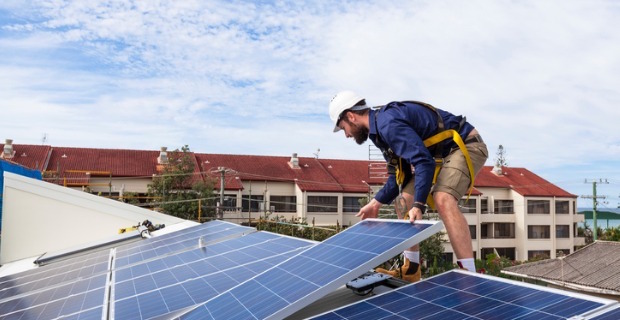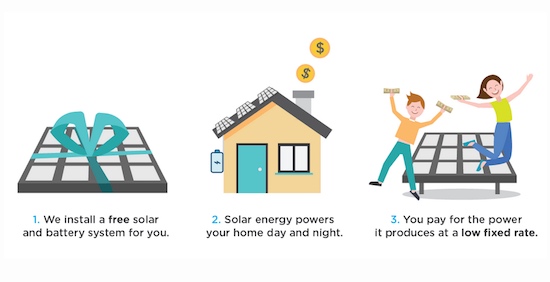 A new solar and storage scheme aims to tackle the problem of “power poverty” in Australia head on, by offering low income households around Australia the option to install both solar and battery storage for no upfront cost.
A new solar and storage scheme aims to tackle the problem of “power poverty” in Australia head on, by offering low income households around Australia the option to install both solar and battery storage for no upfront cost.
The scheme, unveiled by “solar marketplace” ShineHub on Wednesday morning, will initially be open to 1000 households across all states except the Northern Territory and Tasmania.
Households that sign up – people can register their interest via the ShineHub website – will be given the opportunity to install between 3-10kW of rooftop solar PV and 5.7-22.8kWh of battery storage, depending on their consumption profiles and energy needs.
The hardware used will be Tier 1 Longi solar panels, and Alpha ESS batteries and inverters.
The main goal of these installations – which will be tailored to each household by one of 85 high quality installer partners collaborating with ShineHub on the project – is to give the customer somewhere between 70 and 90 per cent “grid independence.”
In this way, they can distance some of the nation’s more vulnerable households from volatile and rising electricity prices, and from the constant threat of bill shock.
But instead of having to stump up thousands of dollars for the privilege, they can do so without having to outlay any money – or perhaps even more importantly, without having to take on any new risk.
This leaves the households paying their chosen retailer for the grid connection, and for whatever electricity they do import. Solar exports to the grid would still be deducted from their bills, as per the local FiT.
On top of that, they enter into a 20-year contract with ShineHub to buy the solar at a “low fixed rate” that ShineHub says will deliver instant bill savings of between 14 per cent (in Victoria) up to 50 per cent (in South Australia), and the option to buy the system out at any point along the way.
It is similar to a scheme proposed by Tesla for low income households in South Australia, although that also came as part of a proposed “virtual power plant” that would link the batteries through software and provide a grid resource.
The fate of that proposal, along with a separate proposal using sonnen batteries to offer zero upfront costs for battery storage, is up in the air following the election of the South Australia government.
So what makes this ShineHub scheme any different – or any more accessible for low-income households – than other pay as you go solar and storage leasing programs?
According to ShineHub CEO Alex Georgiou, there are a couple of key factors that differentiate his company’s Free System Solar program from other such offers on the market.
To start with, it’s not a financial product.
“A lot of people that we talk to are not able to get approved for your typical financing product,” he told One Step in an interview on Tuesday.
“So it’s not a loan, in that sense. It’s (more like) a servicing agreement.
“It’s very accommodating for people stuck in that cycle of power poverty.”
What that also means is that the performance of the solar and battery storage system, from start to finish, is also covered by ShineHub.
And furthermore, the rate that households pay for their solar electricity is directly linked to the system’s output.
“If it doesn’t work,” they don’t pay, Georgiou said. “If the system goes down, they don’t pay. And if it’s cloudy, then the customer pays less.
“We’re taking on all of the risk,” he added. “So any sceptisicm (about the scheme) is covered by the replacement and pay-as-it-works replacement policy.”
So what’s in it for ShineHub? Like any other solar business in the industry, says Georgiou, his company makes its money from “the margins,” as slender as they might be in the Australian market.
Not all of the company’s business is in no-upfront cost transactions – they also install for households and businesses that want to pay up front, and are seeing plenty of demand for solar and storage.
“From our perspective, it doesn’t matter what (payment package) people choose,” Georgiou told One Step. “People can get whatever suits them best.”
That said, however, Georgiou is passionate about the solar revolution being a fair one, and open to all, and sees no reasons whatever why it should not be.
“This is a really good thing, and we’re benefitting people,” he said. “They didn’t think there was an option, and now there is – and they’re taking it up.
“To say that this is a rich person’s solution,” he added, “is … nonsense.”
As noted above, the first round of the Free System Solar scheme will be open to just 1000 households. But Georgiou says he expects, sometime around July, to be opening another round.
And he expects interest to be red hot, particularly in South Australia, where the scheme promises to deliver bill savings of between 35-50 per cent (see the list of rates per state above).
“We are expecting the first issue to be taken up pretty quickly,” he said. “We have had a big response in Adelaide (to a previous offer) – we only had around 150 systems available and over 900 signed up in the first four days.”
But of course another thing that the design of the no-consumer-risk scheme guarantees is that not every household will be the right fit for solar and battery storage.
“It has to work for the household. If their bills are less than $450 per quarter, or they have a lot of shading (on their roof), that sort of thing,” then they won’t be eligible, says Georgiou.
“Most of the time we’re aiming for people to be 80-90 per cent grid independent,” he said.
“But not in all instances. Part of the process is that we have an engineering team that reviews system design, to make sure we’re making the right systems for folks.”
Georgiou says that the households most ideally suited to the scheme will most likely be families, and people looking to retire.
“These are people who use a lot of power, and a lot of times they’re holding back on what they want to do, to keep the budget intact.
“Power prices are one of the only things that are out of their control. This program means they can use their power more liberally.”
This article was originally published on RenewEconomy’s sister site, One Step Off The Grid, which focuses on customer experience with distributed generation. To sign up to One Step’s free weekly newsletter, please click here.







